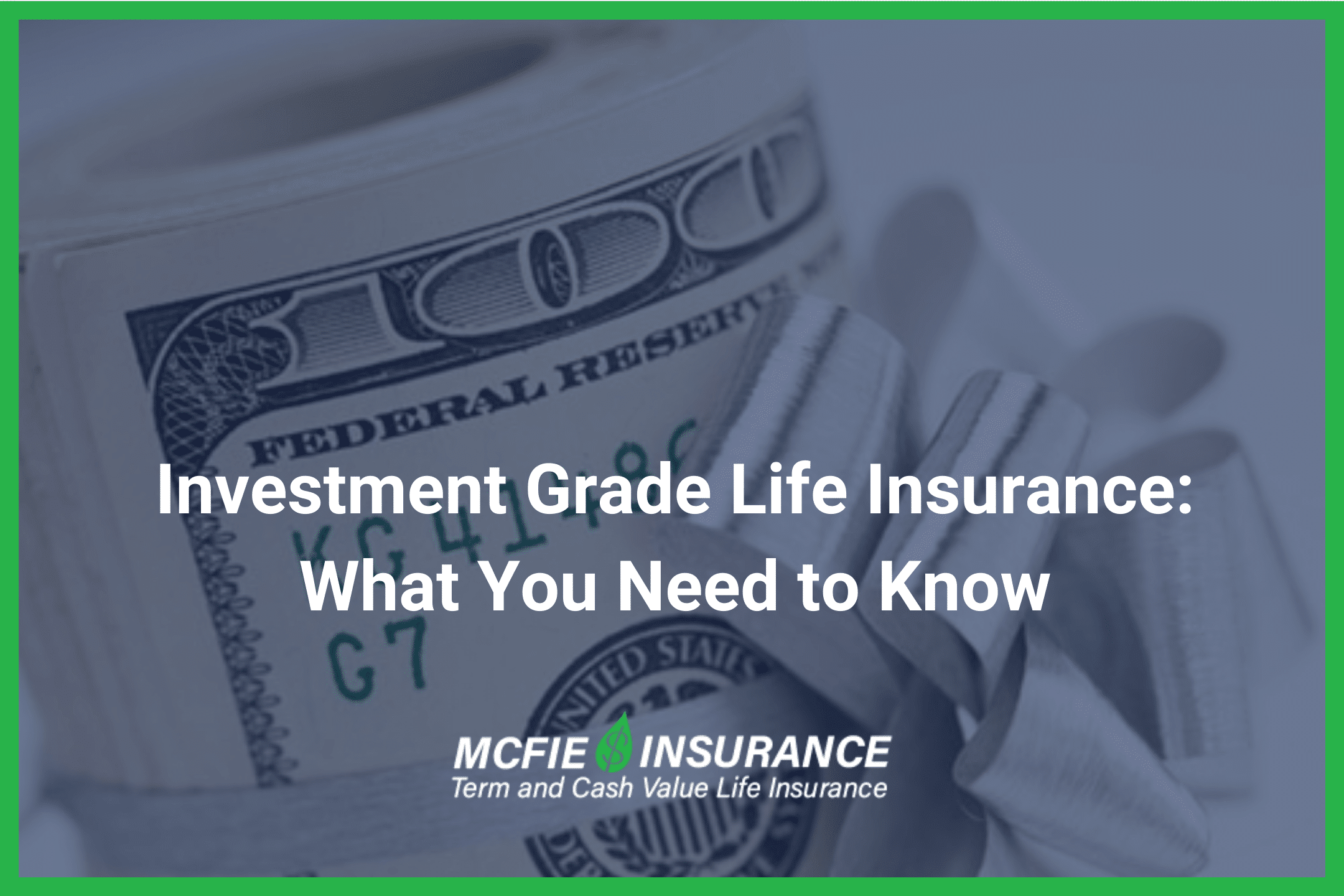Investment Grade Life Insurance: What You Should Know
Investment grade life insurance is a term often used by agents to market whole life insurance policies, but it’s crucial to understand what this phrase truly means. While some whole life policies may offer better options for cash value maximization, the term “investment grade” is not an official designation in the financial world. Instead, it serves as a marketing gimmick intended to attract those wary of traditional life insurance policies. In financial planning discussions, it’s important to discern between effective life insurance policy choices and mere promotional tactics. By recognizing this distinction, consumers can make more informed decisions about their insurance options and avoid falling for potentially misleading claims.
Sometimes referred to as premium life insurance or enhanced whole life policies, investment grade life insurance aims to convey a sense of superiority in the life insurance market. This terminology is designed to shift the focus of potential buyers from common misconceptions about life insurance to its potential benefits, particularly in retirement planning. However, the reality is that this label does not denote any special financial product; it merely highlights variations within whole life insurance contracts. While these policies can serve different purposes, such as maximizing death benefits or cash value, understanding their nuances is key to effective financial strategies. Ultimately, the focus should be on the specific policy features and how they align with individual financial goals, rather than being swayed by catchy marketing phrases.
Understanding Investment Grade Life Insurance
Investment grade life insurance is a term that sparks curiosity among potential buyers, but it is crucial to understand its true nature. Essentially, it is a marketing tactic used by agents to promote whole life insurance policies. While these policies may offer benefits such as cash value accumulation and death benefits, the designation of ‘investment grade’ is misleading. It suggests a level of quality or legitimacy that does not exist in the realm of life insurance products. Instead, consumers should focus on the specific features of whole life policies that align with their financial goals.
The concept of investment grade life insurance attempts to position whole life policies as superior financial instruments, especially for retirement planning. However, this label can mislead consumers into perceiving these products as investment vehicles rather than insurance solutions. Whole life insurance primarily serves as a protective measure for beneficiaries while also accumulating cash value over time. Thus, it is essential to approach this term with caution, recognizing it as a marketing gimmick rather than a legitimate financial classification.
The Misinterpretation of Investment Grade Terminology
The term ‘investment grade’ implies a level of quality that is not officially recognized in the life insurance industry. This misinterpretation can lead to confusion among consumers who are already wary of whole life insurance due to its mixed reputation. Agents may use this term to distract from the negative perceptions associated with whole life policies and instead highlight their potential benefits. However, it is important for consumers to remain informed and critically evaluate what is being offered. Understanding the actual terms of a life insurance policy, rather than getting caught up in marketing jargon, is crucial for making sound financial decisions.
Furthermore, the use of the term investment grade can create unrealistic expectations. Consumers may believe that by purchasing so-called investment grade life insurance, they are securing a superior financial product. In reality, they are simply acquiring a whole life insurance policy that may or may not meet their financial objectives. This can lead to disappointment and financial strain if individuals do not fully understand the implications of their purchase. It is vital to prioritize transparency and clarity over catchy marketing phrases when considering life insurance options.
The Implications of Cash Value Maximization
Cash value maximization is often touted as a significant advantage of whole life insurance policies. However, labeling certain policies as investment grade solely based on their cash value potential can be misleading. While some whole life contracts are designed to enhance cash value accumulation, it is essential to recognize that not all policies are created equal. Consumers should thoroughly research and compare different options to find a policy that aligns with their financial planning goals.
Moreover, the emphasis on cash value can divert attention from the primary purpose of life insurance, which is to provide financial protection for loved ones. It is essential for consumers to strike a balance between maximizing cash value and ensuring adequate death benefits. By understanding the nuances of whole life insurance policies, individuals can make informed choices that serve their long-term financial needs without falling prey to marketing gimmicks.
Separating Marketing Gimmicks from Reality
The phrase ‘investment grade life insurance’ is a prime example of a marketing gimmick that can cloud consumer judgment. While it may sound appealing, it often serves to create an illusion of exclusivity and quality that simply does not exist. Instead of allowing catchy phrases to dictate purchasing decisions, consumers should focus on the core features and benefits of the life insurance policies they are considering. This includes understanding the terms of the policy, potential fees, and how it fits into their overall financial plan.
Many financial advisors stress the importance of being informed and cautious when navigating the life insurance market. By recognizing terms like investment grade as mere marketing strategies, consumers can avoid being swayed by sensational claims. Instead, they can prioritize their financial objectives and seek out policies that genuinely meet their needs, whether that involves cash value accumulation, death benefits, or both.
Navigating Whole Life Insurance Variations
Whole life insurance can come in various forms, each designed to meet different financial objectives. Some policies focus on maximizing death benefits, while others are geared towards cash value maximization. This diversity can often lead to confusion among potential buyers, especially when terms like ‘investment grade’ are introduced. It is crucial for consumers to understand the various options available and how each aligns with their financial goals.
When evaluating whole life insurance policies, consumers should consider factors such as premium payments, cash value growth, and the policy’s long-term objectives. By doing so, they can make informed decisions that are not clouded by marketing jargon. Ultimately, whether a policy is labeled as investment grade or not, its value will depend on how well it meets the individual’s financial planning needs.
The Role of Financial Advisors in Life Insurance Decisions
Financial advisors can play a vital role in helping consumers navigate the complexities of life insurance, especially when it comes to understanding terms like investment grade. By providing clear explanations and guidance, advisors can help clients make informed decisions that align with their financial objectives. This is especially important in the realm of whole life insurance, where marketing tactics can often obscure the true nature of the products being offered.
A knowledgeable advisor will encourage clients to ask critical questions and explore various options before committing to a policy. They can help dissect the features of different whole life insurance products and identify which ones may be best suited for cash value maximization or death benefit coverage. Ultimately, the goal is to empower consumers to make decisions based on solid information rather than enticing marketing labels.
Rethinking Financial Planning with Life Insurance
Incorporating life insurance into financial planning requires a thoughtful approach. While some agents may promote investment grade life insurance as a strategic financial tool, it is essential for consumers to evaluate this within the broader context of their financial goals. Whole life insurance should not be viewed as a primary investment but rather as a component of a comprehensive financial strategy that includes savings, retirement accounts, and other investment vehicles.
By rethinking how life insurance fits into overall financial planning, consumers can better assess its value. This involves considering factors such as liquidity, risk tolerance, and long-term objectives. Understanding that life insurance serves multiple purposes—providing a death benefit while also accumulating cash value—can help individuals make more informed choices that support their financial well-being.
Awareness of Marketing Tactics in Life Insurance
Awareness of marketing tactics, such as the use of terms like investment grade, is crucial for consumers in the life insurance market. Recognizing these strategies can help individuals avoid falling for gimmicky sales pitches and instead focus on what truly matters: the features and benefits of the policies they are considering. By being informed about the common tactics used by agents, consumers can better navigate their options and make sound financial decisions.
Moreover, by educating themselves on the nuances of whole life insurance and its variations, consumers can position themselves to ask the right questions. This empowerment can lead to better outcomes, whether it involves securing adequate death benefits, maximizing cash value, or both. Ultimately, knowledge is power in the life insurance arena, and consumers should not hesitate to seek clarity and guidance from trusted advisors.
The Importance of Transparency in Life Insurance Sales
Transparency in life insurance sales is paramount for fostering trust between agents and consumers. When agents use terms like investment grade, it can create a barrier to understanding the true nature of the products being offered. Consumers should demand clear and straightforward information about the policies they are considering, including their benefits, limitations, and costs. This transparency can help build confidence and enable clients to make informed decisions.
Life insurance is an essential financial product, and consumers deserve to understand what they are purchasing. By advocating for clarity in the life insurance industry, individuals can help eliminate the confusion that often accompanies marketing gimmicks. Ultimately, a transparent sales process benefits both consumers and agents, leading to better satisfaction and long-term relationships.
Frequently Asked Questions
What is investment grade life insurance and is it a legitimate financial product?
Investment grade life insurance is a marketing term used by agents to promote whole life insurance policies. It is not a recognized financial designation, and ultimately, it’s just a clever label to attract buyers without any special significance.
How does investment grade life insurance differ from traditional whole life insurance?
Investment grade life insurance is essentially a whole life insurance policy that is marketed with the implication of being superior for cash value maximization. However, this distinction is misleading; both terms refer to similar products, and the label does not signify any official classification.
Why do agents use the term investment grade life insurance?
Agents use the term investment grade life insurance to divert attention from the negative perceptions surrounding whole life insurance. By using this term, they aim to create intrigue about the potential benefits of whole life policies for financial planning and retirement.
Is investment grade life insurance a good option for cash value maximization?
While some whole life insurance policies can be designed to maximize cash value, labeling them as investment grade is unnecessary and misleading. The effectiveness of a policy for cash value maximization depends on its specific structure, not the marketing label it carries.
Are there different types of whole life insurance that could be considered investment grade?
Whole life insurance contracts can target various objectives, such as maximizing death benefits or cash value. However, the term investment grade does not reflect a legitimate classification among these types; it’s simply a marketing gimmick that lacks regulatory backing.
What are the potential risks of considering investment grade life insurance?
The main risk of considering investment grade life insurance is the potential for misunderstanding its true nature. Many consumers may believe they are investing in a special product, when in fact, they are simply purchasing a standard life insurance policy.
How should consumers approach offers of investment grade life insurance?
Consumers should remain cautious when approached with offers of investment grade life insurance. It’s essential to understand that this term is a marketing tactic and to focus on the specific features and benefits of the whole life insurance policy itself, rather than the label.
Is investment grade life insurance a good strategy for retirement planning?
Using whole life insurance as part of a retirement strategy can be beneficial if structured correctly. However, labeling it as investment grade can lead to misconceptions; it’s crucial to evaluate the policy’s terms and potential cash value benefits rather than relying on marketing jargon.
What should I consider when evaluating a whole life insurance policy marketed as investment grade?
When evaluating a whole life insurance policy marketed as investment grade, focus on aspects like premium costs, cash value growth, death benefit, and the policy’s long-term objectives. Avoid being swayed by marketing labels and assess the policy’s actual performance and alignment with your financial goals.
Can investment grade life insurance be beneficial for my financial planning?
While the term investment grade life insurance may sound appealing, it’s critical to remember that it is essentially just whole life insurance. If the policy is designed for cash value accumulation, it can play a role in financial planning, but the label itself does not guarantee superior benefits.
| Key Point | Explanation |
|---|---|
| Investment Grade Life Insurance | A marketing term for whole life insurance, not an official designation. |
| Purpose of the Term | To create intrigue and divert focus from negative perceptions of whole life insurance. |
| Misleading Nature | The term is unnecessary and can mislead consumers into thinking it has special benefits. |
| Variations of Whole Life Insurance | Different whole life policies can target cash value or death benefits, but calling them ‘investment grade’ is problematic. |
| Potential Harm | This term can mislead consumers and separate them from their biases against life insurance. |
| Marketing Gimmick | Investment grade life insurance is a clever marketing tactic rather than a legitimate financial product. |
Summary
Investment grade life insurance is a term that serves primarily as a marketing tactic rather than a recognized financial product. It aims to reframe consumer perceptions of whole life insurance, suggesting that some policies are more beneficial than others. However, it is crucial for consumers to understand that there is no formal designation for ‘investment grade’ life insurance. By recognizing this, individuals can make more informed decisions about their insurance purchases without falling for marketing gimmicks.






